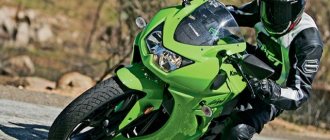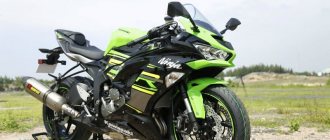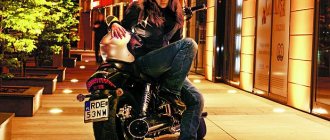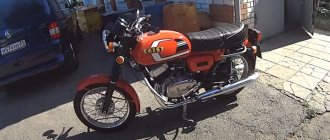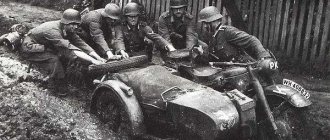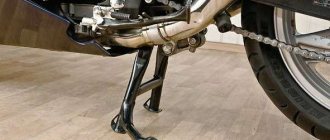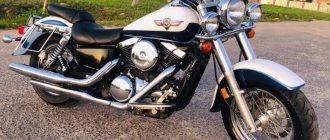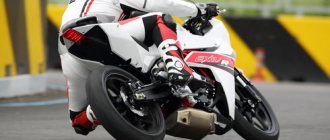Kawasaki is one of the world's largest corporations producing various types of products. For more than a hundred years of history, the company has produced sea vessels, airplanes, helicopters, robots, tractors, jet skis, trains, aircraft engines and even weapons. For example, it was at the Kawasaki plant that the first Japanese submarine was created.
The world's first jet ski was also assembled here. This happened back in 1973 and became a real sensation.
Kawasaki motorcycle history
Our most famous products from Kawasaki Heavy Industries, Ltd are motorcycles and all-terrain vehicles of various types. In 1975, the company began producing motorcycles in the United States.
The history of this corporation goes back decades of research, trial and error, and grandiose discoveries. The technology implemented by Kawasaki engineers was often the first of its kind. People here have always been able to create, invent, and not just copy the work of their colleagues.
Kawasaki motorcycles have always had excellent performance. More than once they managed to become the best.
Kawasaki Ninja
Take for example the now legendary ZX-12R Ninja. Until 2006, it was the world's most powerful production sports motorcycle.
Those who know this model well may either skip the paragraph or become nostalgic. For the rest, we will tell you about the technical characteristics of the Ninja.
Let's start with the engine:
- The Ninja Kawasaki ZX-12R motorcycle is equipped with a DOHC engine with a volume of 1199 cm3. This is a four-cylinder, in-line four-stroke, producing a whopping 185 hp. Torque – 134 Nm at 7500 rpm.
- Fuel system type – injector.
- Electronic ignition. Liquid cooling.
- The model, released back in 2005, is still one of the most powerful in the world.
The Ninja ZX series has been updated and improved more than once. This is not surprising given its enormous popularity.
- Ninja ZZR1400 (Ninja ZX-14R) is a sports-touring model with adjustable engine power. Engine 1441 cc cm, 4-cylinder, four-stroke gasoline unit has a power of 210 hp. Torque 162.5 Nm at 7500 rpm. Gearbox – 6-speed manual.
- Kawasaki ZX-10R motorcycles. 998 cm3 engine, improved brakes and clutch. 200 hp, liquid cooling, digital ignition.
You may also be interested in: Motorcycles produced in China
No less interesting are such models as:
- Z1000SX (Ninja 1000). Consider the 2014 model, with ABS. Braking system – disc (front – two petal discs, rear – one). Engine capacity – 1043 cm3. Power – 142 hp.
- ER-6f (Ninja 650) is a powerful road bike with the attitude of a true athlete. And the engine here is serious - 640 cubic meters, 72 hp, 64 Nm at 7000 rpm.
Now let's move on to the no less interesting Z series.
Kawasaki
And I also read a short test drive: I perfectly understand the organizers’ intention: where else, if not in sunny Spain, can they organize a presentation and road test drive of the new Kawasaki Ninja 250R sports bike. But the weather had its own gloomy thoughts on this matter. Barcelona greeted us “cordially” with rain and everyday traffic jams. Representatives of the “green” company also added to the sentiment. They said that the previous group of journalists, for safety reasons, were deprived of riding on the winding roads of Catalonia, limiting themselves to a tour of Barcelona due to heavy rain. The beginning was encouraging... After lunch, the weather cleared up, the sun was shining, and in order to somehow pass the time before the press conference, I decided to examine the “mini ninja” displayed in the hotel lobby. I think no one will argue - the motorcycle is beautiful. Full-size chopped plastic, a double headlight a la Batman's eyes, a sharp sporty tail and petal brake discs at the front and rear - all this gives the device a unique charm. Faceted rear view mirrors and turn signals in white plastic attract attention and look like external tuning. At the same time, yellow turn signals are available as an option. The model presented in the makeshift showroom was fully equipped with various bells and whistles: there was a tinted high Double Bubble windshield, a passenger seat cover that added a sporty look to the Ninja, and even side sliders. There are no difficulties with choosing a color; you just have to decide which of the two you like better - “Lime Green” or “Ebony”. One can say simply about the instrumentation and controls of the motorcycle: they are straightforward and very comfortable. The instruments are analogue, the glass is practically glare-free, the scales and numbers are made quite large. For me, it would be better to place the tachometer in the center rather than the speedometer, but from the point of view of the developers, this is some element of passive safety for beginners. The switches on the clip-ons are arranged according to the classic canons - everything is convenient, everything is at hand and is located intuitively. In the entire appearance of the motorcycle, only the muffler “can” causes slight doubt; its chrome-plated impressive “carcass” looks like a foreign body. Let's give a hint to caring Kawasaki 250R owners: now you can order small and neat carbon and titanium mufflers for your pet. One disc at the front is enough for the eyes. The rear disc, like the front, is of a petal type. The white turn signal comes stock. In the evening, during the presentation, the organizers paid special attention to the geometry course. In the diagram, three points of support for the motorcyclist on the bike: saddle-clip-ons-pegs, showed the difference in fit with its older brother - the ZX10R. Surprisingly, given the small size of the “quarter”, the seating position is designed for a pilot over 180 cm tall. Well, let’s take it for a ride and test it. The journalists’ question to engine engineer Araya-san sounded almost in Russian: “How much does he eat?” Colleagues in the workshop reacted with heated discussion to the numbers voiced by the Japanese translator. We decided to believe. In conclusion, marketers of potential users of the small “sport”. These are novice motorcyclists, women and middle-aged city residents. These groups are united by a common desire to own a sporty, but “soft” motorcycle with a bright appearance, beautiful sound and the charisma of a real superbike. Can not argue. It was not possible to start the test day on a positive note: it started raining right in the morning. We weren’t worried about the photo shoot - after all, it wasn’t raining, but a gurney “with all the money” obviously wouldn’t work. On the other hand, wonderful conditions for real tests! The fireworks were lit by the instructor leading our group of six little Ninjas through the streets of Barcelona. At some point, a minivan braked quite dynamically in front of him, and the Spaniard grabbed the front brake in surprise - the lowside did not linger. Here I would like to say that driving around the capital of Catalonia during rush hour is not an entirely simple matter. We had to stay tight so that cars and traffic lights didn’t “cut us off” from each other. What I mean is that, having gathered in single file behind the “episode” leader, we all managed to slow down without a hint of extreme behavior, and pressing the brakes also seemed like a difficult task. Passive safety again? While “lacing up” in the aisles, I remembered the declared dry weight of the car. A considerable 154 kilograms are actually quite easily shifted during maneuvers and settle down during braking. Getting the motorcycle to stall in the first two gears or lifting the front wheel at the start is a completely unrealistic task. However, some particularly sadistic testers performed hints of such numbers, but at the same time they made full use of the wet asphalt and mercilessly “raped” the clutch. I was impressed by the shape of the tank and the fit. It was hard to believe in the universality of the landing announced at the presentation, especially considering our own “meter-ninety”. However, somehow the Japanese managed to make the impossible possible, even the knees fit perfectly into the recesses of the tank. Banzai! Having rolled out the planned route through a beautiful European city, we gathered at the next point in order to install a GPS device and set off at our own risk along the winding mountain roads of Catalonia. Already at the beginning of the journey on the motorway, it became clear that for a pilot of my size it was almost impossible to push the needle to the maximum marked 200 km/h. It started to blow me away at 140, and at 160 I gave up. Perhaps the tall glass offered would have helped here, but most likely, I shouldn’t have grown up like that. The winding road abruptly slowed down our pace, my fellow travelers became despondent, and I, who by coincidence was traveling last, increasingly understood that this situation did not suit me. Choosing the moments, and as you understand, the “friendly” engine does not contribute to instant teleportation, I overtook my colleagues one by one and rushed to check the “green Yoda”. I admit, even though the music played for a long time and your humble “fraer” managed to “dance” a lot of people on the serpentines, it all ended with sparks from the titanium sliders of the test pilot’s overalls. A classic and absolutely fabulous lowside brought down the “Jedi” and me on a rather steep descent in a 120° turn. But all's well that ends well: the pilot escaped with a broken finger (I take this opportunity to say hello to the protection, especially the one-piece racing suit), and the motorcycle with several scratches on the fairing, a small crack there and a torn off turn signal. That's all! Excellent crash test. Needless to say, the test subject started up with a kick. After a close inspection of the crash site, it became clear that the cause of the not very shameful, but accident, was not aquaplaning, but ordinary “car spots” that became a kind of ice on the wet asphalt. Upon investigation, it turned out that a small “stud” can still be inserted by “shoe makers” - the Kawasaki 250R is equipped with tires from an unknown manufacturer with an abbreviation of three letters that do not pop up in the “broken” memory. In this regard, urgent advice: if you buy a motorcycle, immediately “change it” into something decent - it will pay off! The rest of the journey was more than calm. Already at the approach to Barcelona, the mocking sun popped up again, but the mood was already peaceful, the motorcycle was purring contentedly, the pilot was enjoying the ease of control and the culture of behavior on European roads. I was so relaxed that I almost ran off to Girona, driving right through the entire Barça. It turned out that in numerous tunnels, losing contact with the satellite, GPS was unable to warn about the required turn. The rider came to his senses only when the roadside landscape became clearly not urban and signs “To Girona” began to appear more and more often. Praise be to civilization, satellites and gadgets - I pressed a couple of buttons and the miracle technology almost itself took me to the hotel entrance. I almost forgot about the burning question. Regarding fuel consumption, I would say that the Ninja does not consume it at all. We were given motorcycles fully fueled, through the city and serpentine roads, according to the odometer, we drove about 150 km. On the way back, the organizers prepared a refueling station, but after opening the tank lid, most of us were stunned by the amount of gasoline splashing and rushed to the hotel without wasting time on “feeding”. It is difficult to give exact figures, but it seems that the “baby” is not capable of drinking more than 5 l/100 km. Although we should not forget about the rainy conditions of the race and, accordingly, the riding style is far from drag racing. Until recently, the bulk of motorcycles traveling on domestic roads were Japanese second-hand ones from 400 cm3 and above. But with each season, the layer of motorcycle users who choose “two wheels” from the position inherent in a pragmatic European city dweller becomes more and more noticeable. Ease of control in urban conditions and fuel consumption are at the forefront. The guys from Kawasaki managed to calculate the “people's need” for such a motorcycle and were ahead of their competitors in the “Japanese four” by at least a season. It is not surprising that the quota allocated for sales in Russia was snapped up like hot cakes even before the equipment arrived in motorcycle dealerships. The Ninja 250R looks, sounds and drives much more than it costs.
